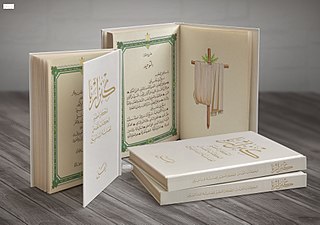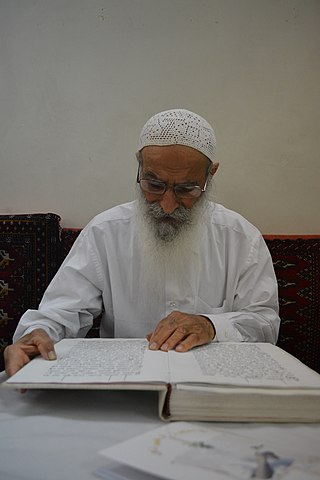
The Ginza Rabba, Ginza Rba, or Sidra Rabba, and formerly the Codex Nasaraeus, is the longest and the most important holy scripture of Mandaeism.

The Qulasta, also spelled Qolastā in older sources, is a compilation of Mandaean prayers. The Mandaic word qolastā means "collection".

A rasta is a white ceremonial garment that Mandaeans wear during most baptismal rites, religious ceremonies, and during periods of uncleanliness. It signifies the purity of the World of Light. The rasta is worn equally by the laypersons and the priests. If a Mandaean dies in clothes other than a rasta, it is believed that they will not reenter the World of Light, unless the rite "Ahaba ḏ-Mania" can be performed "for those who have died not wearing the ritual garment."
The Scroll of Exalted Kingship is a Mandaean religious text. Written as a large illustrated scroll, the text consists of 1363 lines. The scroll is a commentary on the initiation of the tarmida "junior priest".

The Left Ginza is one of the two parts of the Ginza Rabba, the longest and the most important holy scripture of Mandaeism. The other part of the Ginza Rabba is the Right Ginza.
In Mandaeism, Hayyi Rabbi, 'The Great Living God', is the supreme God from which all things emanate.
The Baptism of Hibil Ziwa or Diwan Maṣbuta ḏ-Hibil Ziwa is a Mandaean illustrated scroll. It describes the soteriological descent of Hibil Ziwa to the World of Darkness, and his baptisms before and after. The scroll is essentially also a commentary on the masbuta, or Mandaean ritual baptism.
The Šarḥ ḏ-Zihrun Raza Kasia is a Mandaean religious text that describes rituals such as the masbuta, masiqta, and other related topics. It is an illustrated scroll.

In Mandaeism, the klila is a small myrtle wreath or ring used during Mandaean religious rituals. The klila is a female symbol that complements the taga, a white crown which always takes on masculine symbolism.
The Asut Malkia or Asiet Malkia is one of the most commonly recited prayers in Mandaeism. In the prayer, the reciter wishes health and victory upon dozens of heavenly and ancestral figures. According to E. S. Drower, it is recited daily by priests and also before all baptisms (masbuta), ritual meals (lofani), and various rites.
In Mandaeism, a rahma is a daily devotional prayer that is recited during a specific time of the day or specific day of the week. There is a total of approximately 60 rahma prayers, which together make up the Eniania ḏ-Rahmia, a section of the Qulasta that follows the Asut Malkia prayer.
Daily prayer in Mandaeism, called brakha ࡁࡓࡀࡊࡀ in Mandaic or occasionally birukta (birukhta), consists of set prayers that are recited three times per day. Mandaeans stand facing north while reciting daily prayers. Unlike in Islam and Coptic Orthodox Christianity, prostration is not practiced.
The rushuma is one of the most commonly recited prayers in Mandaeism. It is a "signing" prayer recited during daily ablutions (rishama). The same word can also be used to refer to the ritual signing gesture associated with the prayer.

In Mandaeism, the nishimta or nishma is the human soul. It is can also be considered as equivalent to the "psyche" or "ego". It is distinct from ruha ('spirit'), as well as from mana ('nous'). In Mandaeism, humans are considered to be made up of the physical body (pagra), soul (nišimta), and spirit (ruha).
In Mandaeism, an anana is a heavenly cloud in the World of Light that is considered to be the dwelling place of uthras. An anana can also be interpreted as a female consort.
The following outline is provided as an overview of and topical guide to Mandaeism.
Majid Fandi Al-Mubaraki is an Iraqi-Australian writer and researcher based in the Sydney metropolitan area. He is known for his publications of Mandaic texts, including the Ginza Rabba and Qulasta.
The Sidra ḏ-Nišmata, also known as the Book of Souls or Book of Gadana, is a collection of Mandaean litugical prayers that constitutes the first part of the Qulasta. It most likely constitutes the oldest stratum of Mandaean literature and dates to at least the 3rd century CE or earlier.







